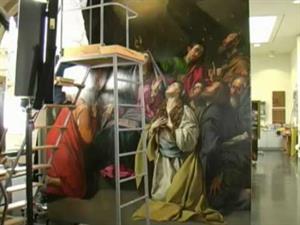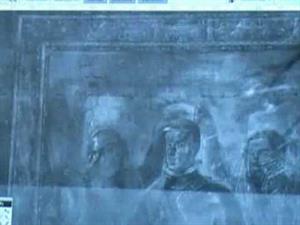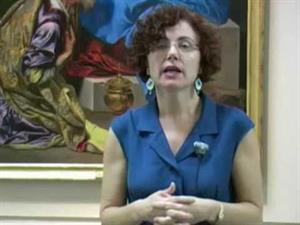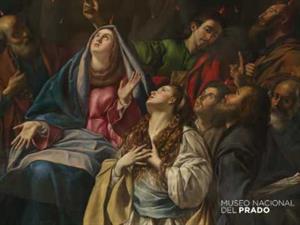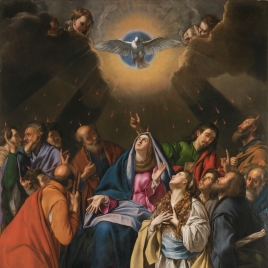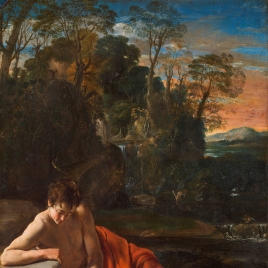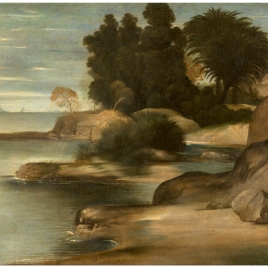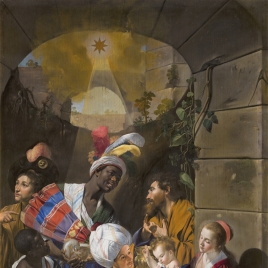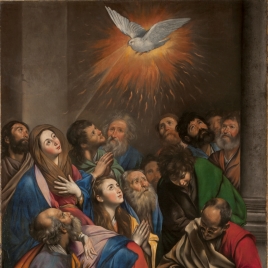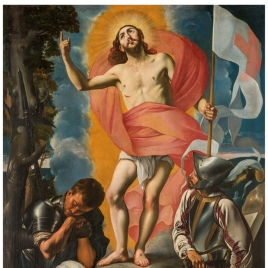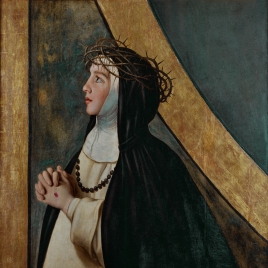Pentecost
1615 - 1620. Oil on canvas.Not on display
Shortly after he painted the Pentecost for the high altar of the church of San Pedro Mártir in Toledo, Maíno executed this second version on a larger scale and in a wider format, which allowed him to position the fourteen figures in the scene in a balanced manner. Mary occupies the centre of the composition with the Apostles on either side of her, six standing just behind her and six kneeling alongside or slightly in front of her. Also kneeling and closer to the viewer is Mary Magdalene, depicted here as a beautiful young woman dressed in a white tunic and gold-coloured cloak.
As in the Pentecost for San Pedro Mártir, all the figures are notably humble social types, dressed in ample tunics and painted with a powerful sense of volume that results from the compact pictorial construction and the strong, contrasting illumination. The two women are depicted using Maíno’s typical classicising idealisation and are close to models by Orazio Gentileschi (1563-1639) and Guido Reni (1575-1642). Mary is portrayed wearing a red tunic with her head covered by a veil and her cloak, as she is also seen in Maíno’s other composition of this title.
The Magdalen is rendered as overtly sensual in type, due in part to her delicate garments and also to her radiant face, which is tilted upwards in a way that conveys profound emotion, a sentiment that is emphasised by the gesture of acceptance and acknowledgement of her hands. Her hair is thick, blonde and wavy, held off her face by a band and falling down in thick locks over her breast. The upper part of the canvas includes a large white dove seen frontally with its wings outstretched. It creates around itself a luminous burst of light that breaks up the intense darkness among which the heads of five cherubim are visible. The Dove of the Holy Spirit is the origin of the small tongues of fire that can be seen hovering over the heads of the figures depicted. All of them observe the miracle in a restrained manner despite the use of a conventional range of gestures not deployed in the earlier version. As Miguel Hermoso Cuesta has noted, this restraint in the affetti is typical of the Bolognese school and is another indication of Maíno’s assimilation of early seventeenth-century Italian art. In the first of the two versions Maíno used a highly original iconography that depicted two parallel episodes, namely the presence of the Holy Spirit above the Apostles and the narration of the miracle through the Gospel account. While Saint Luke occupied a prominent role in that version, in the one here his person is less conspicuous. He appears together with Saint Peter to the side of Mary, holding a text in his left hand while his right hand is extended above the Virgin’s head, pointing to the presence of the Holy Spirit in a gesture that also visually helps to draw attention to the centre of the composition.
Maíno used considerable variety in his depiction of the other Apostles, although they all conform to a humble social type, as noted above. The figure of Saint Peter is similar to other depictions of this saint in the artist’s work, including the colour of the clothes and the traditional presence of the key. A notable feature is the Apostle kneeling on the right, who may be Saint Paul. This figure has features similar to those of Saint Anthony Abbot in the San Pedro Mártir altarpiece. Maíno depicts him looking at the viewer and repeating Saint Luke’s gesture, pointing upwards with his index finger in order to attract our attention.
The x-ray of the canvas does not reveal any modifications or pentimenti in respect to the surface image, thus suggesting that the composition was worked out previously through drawings and sketches that allowed for changes at that stage. This seems logical given the scale of the work, which is the largest of Maíno’s religious compositions.
Aside from the fact that it was in one of the convents in Spain that was disentailed in 1835, the provenance of the painting was unknown until recently. However, we now know that it was painted for the high altar of the convent of the Barefoot Carmelites in Toledo, as revealed by José Álvarez Lopera in his important study on the Museo de la Trinidad. This discovery was made through a comparison of two unpublished inventories relating to the Disentailment, which record a Coming of the Holy Spirit from the Carmelite convent in question of identical size to this Pentecost. While little information is available on this issue, it is known that the convent occupied three different buildings during the course of its history. The first consisted of some buildings that had belonged to a Barefoot community of the Holy Spirit, the name that was used for the new foundation and which is consistent with the subject of this canvas. In 1604 the convent moved to land next to the Alcántara bridge behind the castle of San Servando, where its church was built in 1608.4 On stylistic grounds, the present canvas could date to around 1615, but may also be slightly later.
When it entered the Museo de la Trinidad, the Pentecost was identified by Cruzada as a work by Maíno. At one point it was said that it was signed, which is incorrect. Very few signed works are known by the artist and no signs have emerged to suggest that this particular canvas had a signature at any point in its history (Ruiz, L.: Juan Bautista Maíno: 1581-1649, Museo Nacional del Prado, 2009, pp. 301-302).

